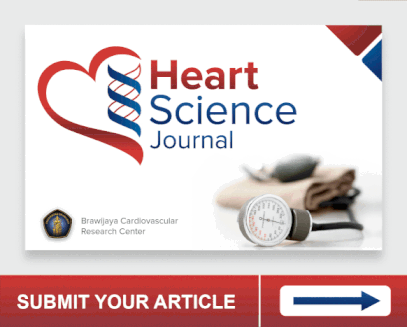The Association between CHA2DS2-VASc Score with Increased Serum Creatinine Level in ACS Patients Undergoing PCI at RSUD dr. Saiful Anwar Malang
Abstract
Background: The current literature on the relationship between the congestive heart failure, hypertension, age, diabetes mellitus, prior stroke or TIA or thromboembolism, vascular disease, age, sex category (CHA2DS2-VASc) score and increased Serum Creatinine (SCr) among Acute coronary syndrome (ACS) patients is noticeably limited in scope. Therefore, the primary objective of this study was to assess the correlation between CHA2DS2-VASc score with increased of Serum Creatinine in patients with ACS undergoing Percutaneous coronary intervention (PCI) procedures.
Material and Methods: In this study, a total of 527 participants were recruited, comprising two groups: Increased SCr level (n=159) and normal SCr level (n=368). Data pertaining to clinical information and demographic characteristics, such as gender, age, diabetes mellitus (DM), hypertension (HT), congestive heart failure (CHF), history of stroke or transient ischemic attack (TIA), and vascular disease, were gathered from various sources, including registry data and medical records, diagnostic physical examination, electrocardiography and laboratory records. Logistic regression analysis was employed to assess the association between the CHA2DS2-VASc score and the incidence of increased SCr level.
Result: In our study, we observed that the CHA2DS2-VASc scores were significantly higher in the group of patients who increase SCr level compared to those who did not increase SCr level. Furthermore, our Receiver Operating Characteristic (ROC) analysis revealed that a CHA2DS2-VASc score cutoff of 3 was determined to be the optimal threshold for estimating the increased SCr level (AUC= 0.805, 95% CI 0.762-0.848; p<0.01).
Conclusion: The CHA2DS2-VASc score serves as a valuable tool for estimating the likelihood of SCr in patients undergoing PCI, offering a foundational assessment. Additionally, in PCI patients, an increase in the CHA2DS2-VASc score exceeding 3 is indicative of a heightened incidence of increased SCr level.
Keywords
Full Text:
PDFReferences
Sedlis SP, Hartigan PM, Teo KK, et al. Effect of PCI on Long-Term Survival in Patients with Stable Ischemic Heart Disease. N Engl J Med. 2015;373(20):1937-1946. doi:10.1056/NEJMoa1505532
Limbong M, Herry Y, Ardhianto P, Suhartono S. Risk score of contrast-induced nephropathy in patients after percutaneous coronary intervention. Bali Med J. 2021;10(1):400-404. doi:10.15562/bmj.v10i1.2222
Sousa-Uva M, Alfonso F, Banning AP, et al. The Task Force on myocardial revascularization of the European Society of Cardiology (ESC) and European Association for Cardio-Thoracic Surgery (EACTS). Published online 2018.
Shibata K, Wakabayashi K, Kosaki R, et al. Ultra-minimum contrast percutaneous coronary intervention for a patient with complex coronary artery disease and end-stage diabetic nephropathy. J Cardiol Cases. 2021;23(6):290-293. doi:10.1016/j.jccase.2021.03.005
Uysal OK, Turkoglu C, Duran M, et al. Predictive value of newly defined CHA2DS2-VASc-HSF score for severity of coronary artery disease in ST segment elevation myocardial infarction. Kardiol Pol. 2016;74(9):954-960. doi:10.5603/KP.a2016.0054
Chou RH, Huang PH, Hsu CY, et al. CHADS2 score predicts risk of contrast-induced nephropathy in stable coronary artery disease patients undergoing percutaneous coronary interventions. J Formos Med Assoc. 2016;115(7):501-509. doi:10.1016/j.jfma.2015.12.008
Kurtul A, Yarlioglues M, Duran M. Predictive Value of CHA2DS2-VASC Score for Contrast-Induced Nephropathy After Percutaneous Coronary Intervention for Acute Coronary Syndrome. Am J Cardiol. 2017;119(6):819-825. doi:10.1016/j.amjcard.2016.11.033
Centola M, Lucreziotti S, Salerno-Uriarte D, et al. A COMPARISON BETWEEN TWO DIFFERENT DEFINITIONS OF CONTRAST-INDUCED ACUTE KIDNEY INJURY IN PATIENTS WITH ST-SEGMENT ELEVATION MYOCARDIAL INFARCTION UNDERGOING PRIMARY PERCUTANEUOS CORONARY INTERVENTION. J Am Coll Cardiol. 2016;67(13):86. doi:10.1016/S0735-1097(16)30087-0
Heyman SN, Rosenberger C, Rosen S, Khamaisi M. Why Is Diabetes Mellitus a Risk Factor for Contrast-Induced Nephropathy? BioMed Res Int. 2013;2013:1-8. doi:10.1155/2013/123589
Andreucci M, Solomon R, Tasanarong A. Side Effects of Radiographic Contrast Media: Pathogenesis, Risk Factors, and Prevention. BioMed Res Int. 2014;2014:1-20. doi:10.1155/2014/741018
Huang SS, Huang PH, Leu HB, Wu TC, Lin SJ, Chen JW. Association of central pulse pressure with contrast-induced nephropathy and clinical outcomes in patients undergoing coronary intervention. J Hypertens. 2013;31(11):2187-2194. doi:10.1097/HJH.0b013e3283641023
Taşolar H. CHA2DS2-VASc-HS score in non-ST elevation acute coronary syndrome patients: assessment of coronary artery disease severity and complexity and comparison to other scoring systems in the prediction of in-hospital major adverse cardiovascular events. Anatol J Cardiol. Published online 2016. doi:10.14744/AnatolJCardiol.2015.6593
McCullough PA, Choi JP, Feghali GA, et al. Contrast-Induced Acute Kidney Injury. J Am Coll Cardiol. 2016;68(13):1465-1473. doi:10.1016/j.jacc.2016.05.099
Liu ZZ, Viegas VU, Perlewitz A, et al. Iodinated Contrast Media Differentially Affect Afferent and Efferent Arteriolar Tone and Reactivity in Mice: A Possible Explanation for Reduced Glomerular Filtration Rate. Radiology. 2012;265(3):762-771. doi:10.1148/radiol.12120044
McCullough PA, Bouchard J, Waikar SS, et al. Implementation of Novel Biomarkers in the Diagnosis, Prognosis, and Management of Acute Kidney Injury: Executive Summary from the Tenth Consensus Conference of the Acute Dialysis Quality Initiative (ADQI). In: McCullough PA, Kellum JA, Mehta RL, Murray PT, Ronco C, eds. Contributions to Nephrology. Vol 182. S. Karger AG; 2013:5-12. doi:10.1159/000349962
Akrawinthawong K, Ricci J, Cannon L, et al. Subclinical and clinical contrast-induced acute kidney injury: data from a novel blood marker for determining the risk of developing contrast-induced nephropathy (ENCINO), a prospective study. Ren Fail. 2015;37(2):187-191. doi:10.3109/0886022X.2014.991994
Thongprayoon C, Cheungpasitporn W, Srivali N, et al. Acute Kidney Injury after Transcatheter Aortic Valve Replacement: A Systematic Review and Meta-Analysis. Am J Nephrol. 2015;41(4-5):372-382. doi:10.1159/000431337
Kovar F, Knazeje M, Mok M. Contrast-Induced Nephropathy: Risk Factors, Clinical Implication, Diagnostics Approach, Prevention. In: Branislav B, ed. What Should We Know About Prevented, Diagnostic, and Interventional Therapy in Coronary Artery Disease. InTech; 2013. doi:10.5772/54036
Modi R, Patted SV, Halkati PC, Porwal S, Ambar S, Prasad MR, et al. CHA2DS2-VASC-HSF score – new predictor of severity of coronary artery disease in 2976 patients. Int Jour Cardiology. 2016.10.093.
DOI: https://doi.org/10.21776/ub.hsj.2023.004.04.4
Refbacks
- There are currently no refbacks.
Copyright (c) 2023 Emil Fathoni, Sasmojo Widito, Setyasih Anjarwani, Budi Satrijo, Valerinna Yogibuana Swastika Putri

This work is licensed under a Creative Commons Attribution 4.0 International License.









